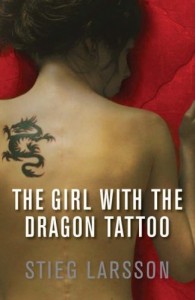Revisiting Larsson’s
The Girl with the Dragon Tattoo

“There’s no such thing as soft or hard oppression of women: men want to own women, they want to control women, they are afraid of women. Men hate women.”
—Stieg Larsson
This is both the first and the second time that I’ve read the famous opening salvo in Stieg Larsson’s Millennium trilogy. Which probably needs some kinds of explanation. The thing is—and I’m kind of ashamed to say it—that first time around I was so taken with what seemed a completely original creation (in as much as that is ever possible) in Lisbeth Salander that I pretty much speed-read The Girl with the Dragon Tattoo. That was a couple of years ago and I’ve always felt a bit bad about that. There’s nothing wrong with getting carried away by a page-turner; but in this case I felt that I was missing out on an awful lot of important stuff. And I was right.
I’ve spent the last week working my way carefully through this magnificent novel and it is a truly fascinating tale. By now the story is well known, so just a brief summary:
In Sweden Mikael Blomkvist, a journalist with the hard-hitting financial magazine Millennium is asked by wealthy industrialist Henrik Vanger to dig into a forty year old murder mystery involving one of his appalling family. He takes on as his research assistant the brilliant, asocial Lisbeth Salander—and in the course of their investigation they find themselves hunting a really twisted serial killer.
If that makes you think that this has been done a hundred times, forget it. The wealth of detail that Larsson presents (without ever being boring) as he guides us through their year-long journey is alone enough to set it apart; but he adds to that some really vivid characters.
It came as a surprise this time around to find that for a lot of the first half Salander is very much a supporting character. Gothic anorexic in appearance–although she can eat to beat the band—and with a genius and photographic memory that seems to border on Asperger’s Syndrome, she is such a brilliantly conceived character that I had remembered her as featuring more prominently. When she does let loose, though, you don’t forget it–as in her vicious and well-deserved torture and tattooing of a bound and tasered rapist.
In fact Blomkvist and Salander don’t actually become a team until around page 300. Much of the first half of The Girl with the Dragon Tattoo is given over to discussions of corrupt high finance in Sweden and the inadequacies of that country’s bankers and financial reporters who are described at best as incompetent and at worst as bent as bejeezus. There were times when you could have been forgiven for thinking that he was talking about Ireland. And his summing up of his fellow journalists (Larsson was one) couldn’t have made him many friends.
Yet he puts into the mouths of his characters what we—or at least I do—often feel ourselves:
“The Stock Exchange is something very different [to the economy]. There is no economy and no production of goods and services. There are only fantasies in which people from one hour to the next decide that this or that company is worth many billions, more or less. It doesn’t have a thing to do with the reality or with the Swedish economy.”
As for Salander, I have always felt as she does: that the bleating of how a rapist or a murderer’s past abusive childhood has made him what he is, just doesn’t cut any ice. I’m not interested in their story. They know that they’re doing evil things, so don’t do them. The bleeding-heart garbage that people like Salander and I have to listen to makes me realise why the world is in such a mess. There are some fools who would rather listen to the perpetrator and how tough he had it as a kid than extend sympathy for the victim.
Why the hell do some people find this book to be misogynistic? How blind can they be? It is clearly written by a man who has a horror of what men do to women. He even quotes vicious statistics of sex crimes at the beginning of the book’s four main sections; and his original title—and the one he always used—was Men Who Hate Women. And there is a deep loathing throughout the book towards these kind of men. Which may be why I liked it so much, having a disgust with these creatures myself.
There is a story that Larsson himself had witnessed the rape of a female acquaintance by three of his friends during a camping holiday when he was fifteen, and that the girl’s name was Lisbeth. He seems to have been haunted by his failure to attempt to stop the crime. This story has been disputed but I can imagine it happening to the man who wrote this angry novel.
We’ll never know as Larsson died at the age of fifty shortly after handing in the manuscripts for his three books; but what a trilogy he has left us.


Recent Comments